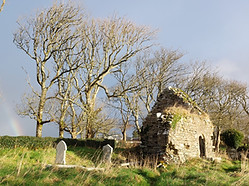
Old Killaghtee
Church and Graveyard
GPS: 54.627107, -8.380967
Location
The old Killaghtee Church and Graveyard, also known as Spamount Graveyard, can be found at the NorthWest end of St. John's Point, along a short path. Pass through the old wrought iron gates beside the road. The site is owned by Donegal County Council and open to all. The very uneven ground makes access not suitable for all.
The site includes both the remains of the old Church and the Killaghtee Cross. There are also multiple graves, each with their own history, some known, some not.


In 2022 the site was successfully 'Adopted' under the Adopt a Monument scheme by the Old Killaghtee Conservation Group, which consists of Dunkineely Community Ltd, local churches, local farmers and others in the community.
A conservation report on the site, funded by the Heritage Council, was carried out and conservation work is ongoing.
The Old Killaghtee Church
The architecture of Killaghtee Old Church would suggest that it was built in the early to mid 12th Century and it would have been a thatched structure[1]. The Select Vestry of the Church of Ireland suggest it was built in 1118; it therefore predates the Friary in Ballysaggart by several hundred years.
Around 1654 it became a Protestant Church, probably due to the ‘Plantations’ when the area was colonised by settlers from the United Kingdom.


This history makes the site important for both Catholic and Protestant Churches and individuals from both faiths are buried in the graveyard.
The name Killaghtee, or ‘Ceall Leacht Aodha’, is translated in the OS Parish Namebooks as ‘The Church of Hugh’s leacht or monument’. Presumably the leacht refers to the Killaghtee Cross (see below).
While only the East wall and half the South wall remain, there are some interest features. The best example is the East window, which has interesting late Romanesque or transitional detail that would come from around the 12th century.
Before
A conservation survey in 2022 revealed that the mortar, partially collapsed South wall and the East window, all needed conservation work if they were to survive.
Dunkineely Community Ltd was able to deliver on this priority work in 2023. It was carried out by Triur Construction and funded by the Community Monument Fund. Dedalus Architecture worked with all parties, at every stage, to ensure the work was completed to a high standard.
All the work was carried out using mortar sympathetic to the original and with stones collected from the collapsed South wall.

After

The Killaghtee Cross
Probably the most famous artifact in the area is the Killaghtee Cross.
The gravestone is a cross-inscribed slab, which typically date from around 650AD, and is thought by some to mark the grave of an early monk, Aodh who was thought to have had a "cell" (little hut for prayer and contemplation) there. Some even believe it marks the grave of St. Aedh.
The term Leacht refers to a monument. So more likely, the term Cill Leacht Aoidh, rather than Cill Aoidh, signifies a connection with an unspecified ancient monument, placed by Aodh. Possibly the Killaghtee Cross itself, rather than a monk named Aoidh.
The cross is important because it marks the transition from the flat grave slabs to the upright Celtic crosses which it pre-dates.
The carving on the top of the cross is a Maltese Cross and can still be seen quite clearly. To the bottom right below the Maltese Cross, although now barely discernible, there is a carving of the triple knot of St. Bridget which represents the Holy Trinity.
Despite hundreds of years of Donegal weather, the cross is still in reasonable condition. It is currently being monitored for erosion, to see if protection is required going forward.
Check out the 3D images of the cross and church on this sites Home page.

The Cholera Graves
Cholera devastated the old village of Dunkineely and the victims were so numerous that their remains could not all be accommodated in the old graveyard so they were buried in a field. The cholera plague was rampant here about the year 1847.
The site of the burial ground is thought to be South of the Old Killaghtee Graveyard, between it and the sea.

